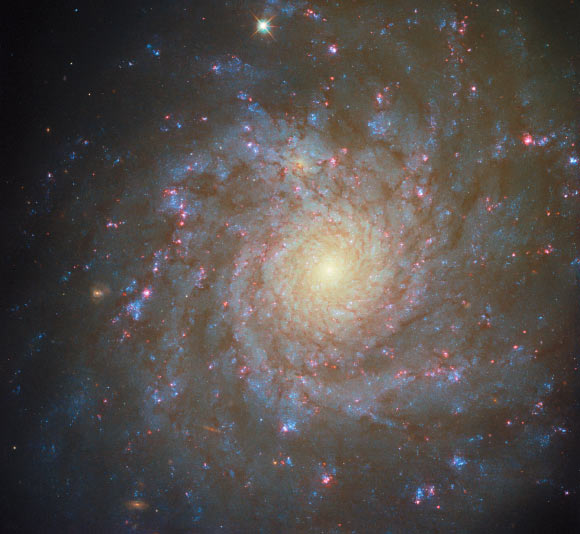This image taken with the NASA/ESA Hubble Space Telescope provides a detailed new look at the star-studded spiral galaxy NGC 4571.
This Hubble image shows NGC 4571, a spiral galaxy some 60 million light-years away in the constellation of Coma Berenices. Image credit: NASA / ESA / Hubble / F. Belfiore / J. Lee / PHANGS-HST Team.
NGC 4571 is located 60 million light-years away in the constellation of Coma Berenices.
This galaxy was discovered by the German-British astronomer William Herschel on January 14, 1787.
Otherwise known as IC 3588, LEDA 42100 or UGC 7788, it is classified as a low-surface brightness spiral galaxy.
NGC 4571 is part of the Virgo cluster, which contains more than a thousand galaxies.
This cluster is in turn part of the larger Virgo supercluster, which also encompasses the Local Group which contains our own Milky Way Galaxy.
“NGC 4571 dominates the scene with its feathery spiral structure and sparkling star clusters,” the Hubble astronomers said about the new image.
“The galaxy’s dusty spiral arms are dotted with brilliant pink nebulae that contain massive young stars.”
“Though the star-forming clouds that are seen here are heated to roughly 10,000 K by searing ultraviolet light from the young stars at their cores, stars get their start in much chillier environments.”
“The sites of star birth are giant molecular clouds tens to hundreds of light-years across, in which the temperature hovers just a few tens of degrees above absolute zero.”
“The dramatic transformation from freezing gas cloud to fiery young star happens thanks to the immense pull of gravity, which collects gas into dense clumps within a star-forming cloud.”
“As these clumps yield to gravity’s pull and collapse inward, they eventually become hot and dense enough to spark nuclear fusion in their centers and begin to shine.”
“The glowing clouds in this image surround particularly massive stars that are hot enough to ionize the gas of their birthplaces.”
In 2022, the Hubble team captured a detailed image of NGC 4571 as part of an observing program that combined data from leading observatories like Hubble, the NASA/ESA/CSA James Webb Space Telescope, and the Atacama Large Millimeter/submillimeter Array.
“The new image released today adds data from a program that seeks to understand how dust affects our observations of young stars deeply embedded within their natal clouds,” the astronomers said.

